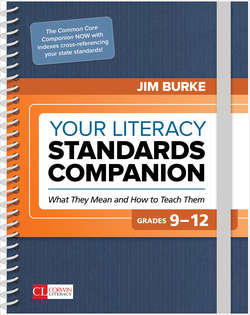Читать книгу Your Literacy Standards Companion, Grades 9-12 - Jim Burke - Страница 40
На сайте Литреса книга снята с продажи.
Common Core Reading Standard 1: Academic Vocabulary: Key Words and Phrases
ОглавлениеAnalysis of primary and secondary sources: Primary sources are those accounts recorded from people who witnessed or participated in the event themselves; these sources include journals, letters, oral history recordings; secondary sources are those written by others based on primary sources and the opinions of scholars past and present.
Attending to such features: Close reading demands paying attention to any features, such as format, source, or date published, that might add subtle but noteworthy meaning to the document.
Cite specific textual evidence: All claims, assertions, or arguments about what a text means or says require evidence from within the text itself, not the reader’s opinion or experience; students should be able to quote or refer to a specific passage from the text to support their idea.
Conclusions drawn from the text: Readers take a group of details (different findings, series of events, related examples) and draw from them an insight or understanding about their meaning or importance within the passage or the text as a whole.
Connecting insights gained from specific details to an understanding of the text as a whole: It is not enough to discern the meaning of a small detail; close reading demands connecting all the dots to reveal how these small details contribute to the meaning of the larger text.
Explicitly: Clearly stated in great or precise detail; may suggest factual information or literal meaning, though not necessarily the case.
Gaps or inconsistencies in the account: Some gaps are intentional, meant to leave room for interpretation or allow for some ambiguity that adds depth and complexity to a text; unintended gaps or inconsistencies undermine the credibility of the work or author by raising questions about the accuracy or reliability of the information.
Important distinctions the author makes: Authors draw a line at times between ideas, categories, or certain elements, attributing more meaning or importance to one than another.
Informational text: These include nonfiction texts from a range of sources and written for a variety of purposes; everything from essays to advertisements, historical documents to op-ed pieces. Informational texts include written arguments as well as infographics.
Literature: This text can include not only fiction, poetry, drama, and graphic stories but also artworks, such as master paintings or works by preeminent photographers.
Logical inferences: To infer, readers add what they learned from the text to what they already know about the subject; however, for the inference to be logical, it must be based on evidence from the text.
Read closely (or close reading): Reading that emphasizes not only surface details but the deeper meaning and larger connections between words, sentences, and the full text; this also demands scrutiny of craft, including arguments and style used by the author.
Strong and thorough textual evidence: Not all evidence is created equal; students need to choose those examples or quotations that provide the best example of what they are saying or most compelling quotation to support their assertion.
Support conclusions: Related to citing textual evidence, this phrase requires readers to back up their claims about what a text says with evidence, such as examples, details, or quotations.
Text: In its broadest meaning, a text is whatever one is trying to read: a poem, essay, essay, or article; in its more modern sense, a text can also be an image, an artwork, speech, or multimedia format such as a website, film, or social media message, such as a Tweet.
Where the text leaves matters uncertain: The writer may intend to be ambiguous or unclear to imply a lack of clarity or resolution about this subject; it can also mean the writer did not tie up loose ends, thus, creating a weak link in an argument or narrative.
